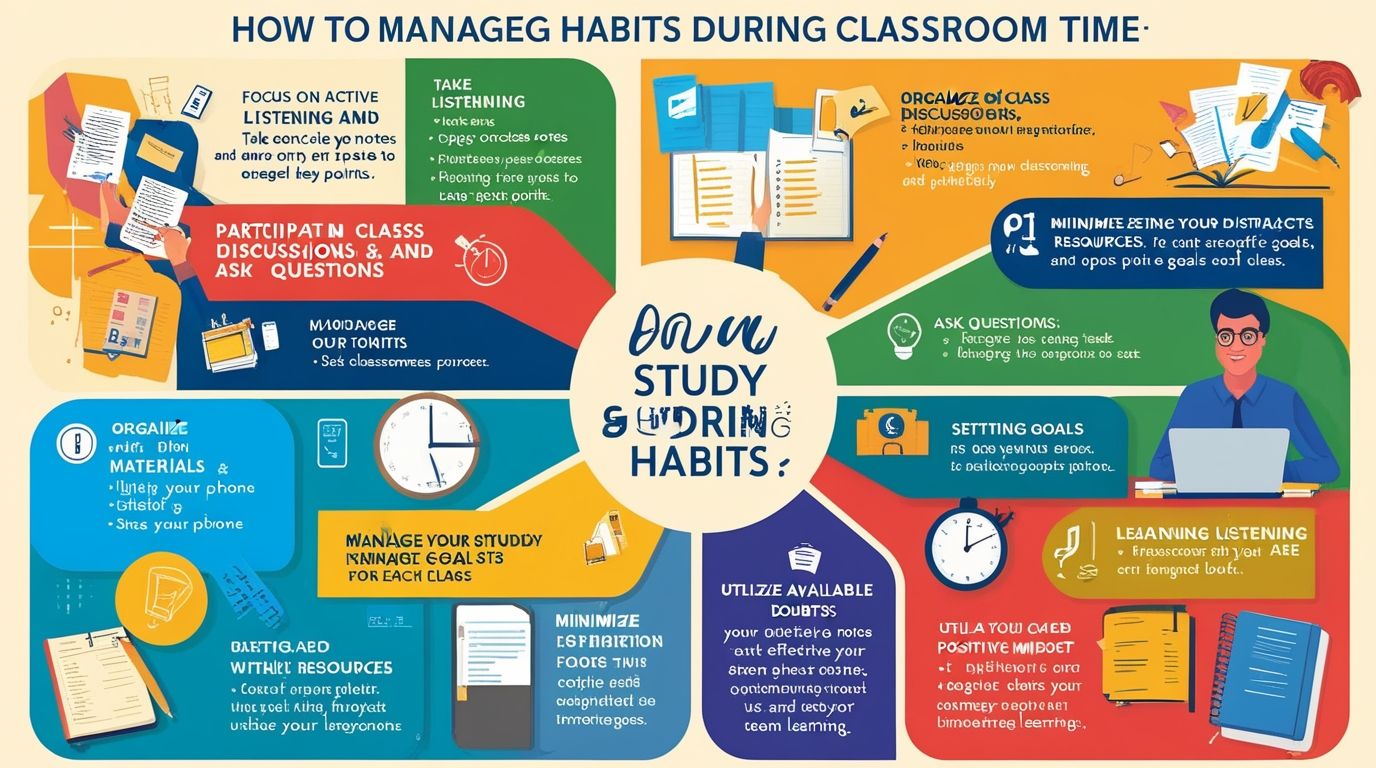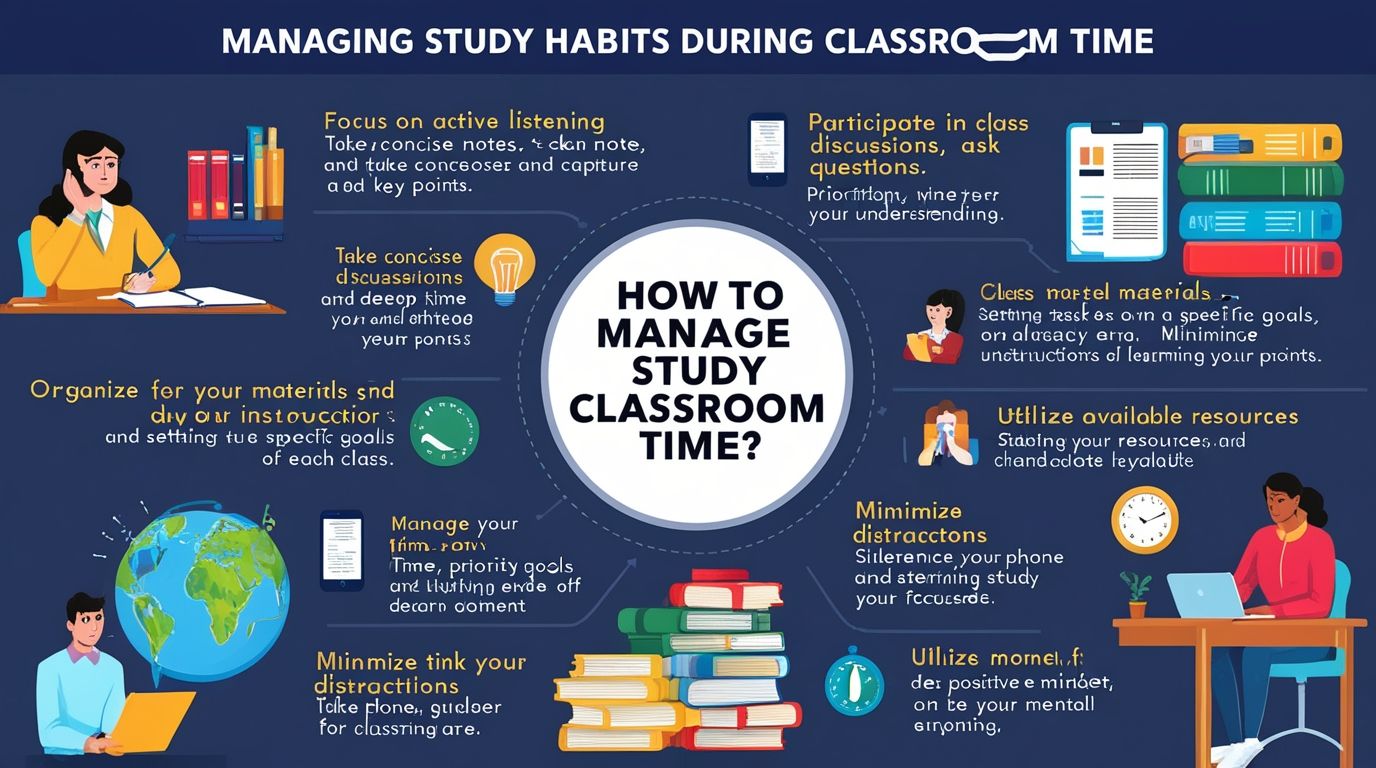How to Manage Study Habits During Classroom Time, Effective study habits during classroom time are crucial for academic success. These habits help students to stay engaged, retain information, and maximize the benefits of their learning experiences. Managing study habits in the classroom is not just about paying attention; it also involves organizing materials, participating actively, and employing strategies that enhance focus and comprehension. This article explores several strategies to manage study habits effectively during classroom time.
1. Active Listening and Note-Taking
One of the most important aspects of managing study habits during classroom time is active listening. Active listening involves fully concentrating, understanding, responding, and remembering what is being said. This means that students should avoid distractions, maintain eye contact with the instructor, and mentally engage with the material being taught. Active listening helps in better comprehension and retention of information.
Note-taking is a complementary skill to active listening. It involves jotting down key points, concepts, and information in a structured manner. Effective note-taking techniques include the Cornell method, mind mapping, and outlining, which help in organizing information logically and making it easier to review later. Notes should be concise but comprehensive, capturing the essence of the lecture without transcribing it verbatim.
To enhance note-taking, students should review their notes soon after the class to reinforce the material learned and fill in any gaps while the information is still fresh in their minds. This process not only solidifies the content but also prepares them for future assessments.
2. Participating Actively in Class
Active participation in class discussions and activities is a key study habit that can significantly improve learning outcomes. When students ask questions, contribute to discussions, and engage with peers, they deepen their understanding of the subject matter. This engagement encourages critical thinking, helps clarify doubts, and allows students to explore different perspectives.
Classroom participation also includes responding to instructors’ questions, volunteering for demonstrations, and collaborating with classmates on group activities. Such participation fosters a dynamic learning environment where students feel more connected to the content and to each other, thereby enhancing their overall learning experience.
Furthermore, participating in class helps students develop communication skills, build confidence, and become more comfortable with public speaking and expressing their ideas. These skills are not only beneficial for academic success but also for personal and professional growth.
3. Time Management and Organization
Effective time management and organization are essential components of good study habits during classroom time. Students should arrive prepared with all necessary materials, such as textbooks, notebooks, writing instruments, and any assigned readings or homework. Being organized helps reduce anxiety and allows students to focus more on learning rather than scrambling for materials.
Time management within the classroom also involves prioritizing tasks and managing one’s attention span. Students should aim to tackle the most challenging tasks when their concentration levels are highest. For example, they might choose to pay extra attention during the introduction of new topics or complex subjects, as these require more cognitive effort.
Using planners or digital tools can help students keep track of assignments, deadlines, and important dates. Setting reminders and breaking tasks into manageable chunks can prevent procrastination and last-minute cramming, which often leads to stress and poor performance.

4. Minimizing Distractions
Distractions in the classroom can significantly hinder effective study habits. Common distractions include mobile phones, side conversations, and daydreaming. To manage these distractions, students should adopt strategies such as turning off or silencing their devices, sitting away from disruptive peers, and focusing their attention on the instructor.
Creating a mental checklist can help students stay on track. This checklist might include actions such as focusing on the lesson, maintaining good posture, and regularly checking if they understand the content. If they find their mind wandering, students should gently refocus by taking a deep breath and directing their attention back to the lesson.
Some students find it helpful to sit in the front rows of the classroom, as this minimizes the likelihood of getting distracted and makes it easier to engage with the instructor. Additionally, maintaining a positive attitude towards learning can motivate students to stay focused and overcome distractions.
5. Setting Goals and Self-Monitoring
Setting clear and achievable goals for each class session can guide students’ focus and efforts. For instance, students might set goals to understand a particular concept, complete a set of notes, or participate in a discussion. These goals provide a sense of purpose and direction during class time.
Self-monitoring is another effective study habit that involves students assessing their own understanding and performance. Techniques such as self-questioning, summarizing the material, and periodically reviewing notes during the class can help students gauge their comprehension. If they notice gaps in their understanding, they can ask questions or seek clarification immediately.
Using self-monitoring tools like learning logs or reflection journals can also be beneficial. These tools encourage students to reflect on what they have learned, identify areas of difficulty, and plan for improvement. Regular self-assessment helps students become more aware of their learning processes and take proactive steps to enhance their study habits.
6. Utilizing Available Resources
Students should take full advantage of the resources available in the classroom, including the instructor, textbooks, and other materials. Asking the instructor for clarification, elaboration, or additional resources can provide a deeper understanding of the subject matter. Instructors are valuable resources who can offer insights and explanations that go beyond the textbook.
Classmates can also be valuable resources. Collaborative learning through study groups or peer discussions allows students to share knowledge, clarify doubts, and learn from each other. Such interactions can reinforce learning and provide different perspectives on the same topic.
Moreover, many classrooms are equipped with technology that can aid learning, such as interactive whiteboards, projectors, and educational software. Utilizing these tools effectively can make the learning experience more engaging and accessible.
7. Developing a Positive Mindset
Maintaining a positive mindset towards learning is fundamental to managing study habits in the classroom. A positive attitude can increase motivation, reduce anxiety, and improve overall performance. Students should approach learning with curiosity and an open mind, viewing challenges as opportunities for growth rather than obstacles.
Positive reinforcement, such as rewarding oneself for meeting goals or mastering a difficult concept, can also motivate students to maintain good study habits. Celebrating small achievements encourages perseverance and fosters a sense of accomplishment.
In addition, students should practice self-compassion and avoid being overly critical of their mistakes. Mistakes are a natural part of the learning process, and viewing them as learning opportunities can help students stay resilient and continue to strive for improvement.
8. Maintaining Physical and Mental Well-being
Finally, good study habits are closely linked to a student’s overall well-being. Proper sleep, nutrition, and exercise play a crucial role in maintaining focus and cognitive function during classroom time. A well-rested and nourished body is better equipped to handle the demands of academic life.
Students should also be mindful of their mental health. Stress management techniques such as deep breathing, mindfulness, and taking short breaks when needed can help maintain concentration and reduce anxiety. Being mindful of one’s mental and physical state allows students to make adjustments that support optimal learning.
Conclusion
Managing study habits during classroom time is essential for academic success. By employing strategies such as active listening, effective note-taking, time management, minimizing distractions, setting goals, utilizing available resources, developing a positive mindset, and maintaining physical and mental well-being, students can enhance their learning experiences and achieve their academic goals. These study habits not only contribute to better performance in the classroom but also foster lifelong skills that benefit students beyond their academic careers.
References
- Dunlosky, J., Rawson, K. A., Marsh, E. J., Nathan, M. J., & Willingham, D. T. (2013). Improving Students’ Learning with Effective Learning Techniques: Promising Directions from Cognitive and Educational Psychology. Psychological Science in the Public Interest, 14(1), 4-58.
- Van Blankenstein, F. M., Dolmans, D. H., Van der Vleuten, C. P., & Schmidt, H. G. (2011). Which cognitive processes support learning during small-group discussion? The role of providing explanations and listening to others. Instructional Science, 39(2), 189-204.
- Credé, M., & Kuncel, N. R. (2008). Study Habits, Skills, and Attitudes: The Third Pillar Supporting Collegiate Academic Performance. Perspectives on Psychological Science, 3(6), 425-453.

7 thoughts on “How to Manage Study Habits During Classroom Time”
Comments are closed.